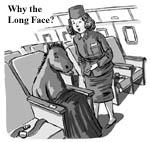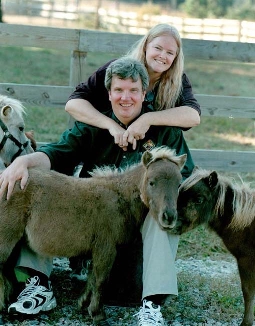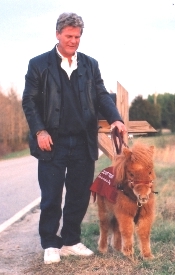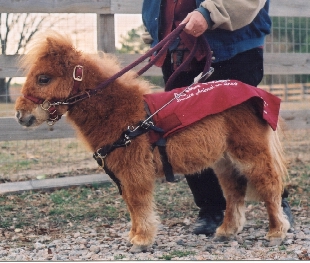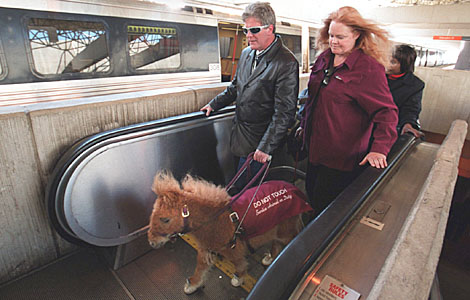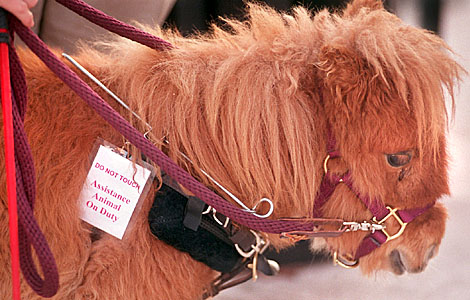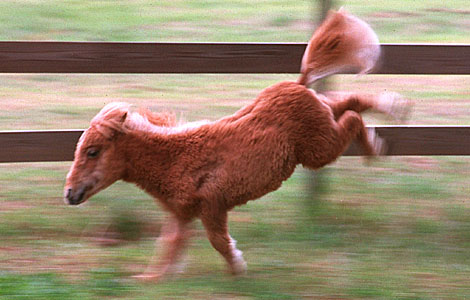|
The Guide Horse
Foundation A non-profit charity dedicated to providing free guides for visually impaired individuals. |
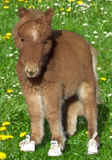 |
|
Field intelligence testing for Guide Horse Candidates Intelligence in horses is quite different from other domestic animals. Because horses have evolved as prey animals, the intelligence of a horse is quite different that that of a predatory animal, and different metrics must be used to measure intelligence. When attempting to measure equine intelligence, we generally look for equine intelligence along three dimensions: Scope of learning – determining the cognitive ability of a horse to solve increasingly complex problems. Rate of learning - A quantitative measure of the time required for the horse to learn the task. Retention of learning – The ability of the horse to remember the learned behavior. The intelligence of horses is often represented as an evenly distributed bell curve, with approximately 80% of horses falling within two standard deviations from the mean. This distribution of equine intelligence suggests that it is possible to develop a field test to identify those horses with superior intelligence. While it is not practical to administer clinical testing in the field, the Guide Horse Foundation has developed a reliable field test for measuring equine intelligence. To be accurate, a field test of intelligence must measure the alertness of the horse and manner in which the horse interacts with the environment. The field test consists of the following areas: Ear reflex index – Alert horses with a high degree of ear motility tend to be more intelligent and a measure of the ear reflex index can discern the intelligence of the horse. Pressure Response - Measuring sensitivity and response to pressure can often reveal the hoses intelligence. Intelligent horses respond quickly and decisively to applied pressure. Response to socialization – Intelligent horses have mastered equine social behavior and display the proper “etiquette” when interacting with other horses and people. Umveg testing – Intelligent horses are able to navigate a detour to achieve a goal. While each of these tests are somewhat subjective and difficult to quantify, they provide a fairly accurate measurement to equine intelligence. To show how each metric is gathered, let’s examine the details of each field test. Ear motion IndexThe first phase of the field intelligence test measures the relative ear motion of the horse. All horses have a range of motion of 170 degrees, and intelligent horses demonstrate frequent and independent ear motion. In the field, two trainers administer the ear motion test. One stands near the left front of the horse and the other persons orients themselves at the right rear. As the trainers walk around the horse, the intelligent horse will follow the person with their ears, tracking their motion independently from the other ear. A less intelligent horse will remain with their ear in the “neutral position, with the ears facing 30 degrees forward, while the intelligent horse will demonstrate rapid and independent ear motion. Pressure ResponseMost horse trainers rely of the “release of pressure” method to train a horse. In nature, horses are programmed to move into pressure as a survival technique. For example, if a wolf clamped-down on the horse’s nose, the horse will not pull away and risk having its nose torn. Rather, the horse will move “into” the pressure, thereby decreasing the chance of loosing the appendage. Horse trainers have long known that the mark of a smart horse is their responsiveness to pressure as evidenced by their direct and purposeful moving “into” physical pressure. To test this in the field, the trainer will spread their fingers and press hard on the side of the horse, directly below the withers. An intelligent horse will immediately lean-into the trainers hand, while the less intelligent horse will either fail to respond to the pressure or move away from the source of the pressure. Response to SocializationAs a herd animal, horses communicate frequently with other horses and learn a variety of social interaction skills. Their mastery of social etiquette can be measured, and the more intelligent horse learns quickly to response to social cues in an appropriate manner. The simplest test of horse socialization skill is the process of greeting. To illustrate, let’s review how two horses meet. Two horses always approach each other with their necks extended and their head’s bowed. They then touch noses and exchange scents by blowing short blasts of air into each other’s nostrils. This blowing of air is done is short puffs, about two per second until the scent is acknowledged. This greeting is the human equivalent of exchanging business cards, and is analogous to dogs introducing each other by sniffing. Once the introduction is completed, the horses move to the next phase, where they "squeal" at each other. Horses are very concerned about their status in the horse hierarchy, and in this phase the horses will challenge each other, sometimes striking out with their front legs. This behavior will continue until one of the horses will show signs of submission. In the field, the trainer can gauge the horse's mastery of social etiquette by greeting the horse as a fellow equine. The trainer approaches the horse from the front, places their face adjacent to the horse’s snout and blows short puff of air up the horse’s nostrils. An intelligent horse will always display a visible reaction at this greeting and will widen their eyes and point both of their each straight forward. A less intelligent horse will not respond with the appropriate actions. Umveg TestingUmveg is the process of taking a detour in order to reach a goal. In horses, the ability to do an umveg is an undisputed sign of superior intelligence. For a field test, the horse is lead to one side of an open-ended ten foot wire fence and given a treat. Next, the horse is lead around to the other side of the fence and a treat is place into a bowl directly opposite the horse. An intelligent horse will turn away from the food and circumnavigate the fence to get the food, while a less intelligent horse will stand on the opposite side of the fence and paw the ground. In practice, the more intelligent the horse, the faster they will recognize the need to move away from the treat to get around the fence. |
Guides Training Press Photos News Apply FAQ Wishes Contact Home
|
Copyright © 1998 - 2004 by the Guide Horse Foundation Inc. Guide Horse ® is a registered trademark of the Guide Horse Foundation Inc.
|
|
Get the Book!
|
Now you can read the book that tells the
story of the development of the Guide Horse training program! Learn the
techniques used to train a reliable, safe service horse.
|
The Guide Horse Foundation has the utmost respect for The Seeing Eye® and their seventy-two years of outstanding work with assistance animals for the blind. Please note that The Guide Horse Foundation is not affiliated with or sanctioned by the Seeing-Eye® or any of the Guide Dog training organizations. Seeing-Eye® is a registered trademark of the Seeing-Eye, Inc.
Смотрите информацию помощь в оформлении визы c5 в казахстан у нас на сайте. . lemon suction vibrator
